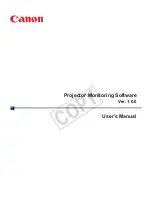
13
Positioning your projector
Eng
lish
Obtaining a preferred projected image size
The distance from the projector lens to the screen, the zoom setting, and the video format each factors in
the projected image size.
This projector is equipped with a movable lens. See
"Shifting the projection lens" on page 16
for details.
You can see the diagrams on pages
14
and
15
for the vertical offset values in the dimension tables that are
measured when the lens is shifted fully up or down.
If you are using a 120-inch, 4:3-aspect-ratio screen, please refer to
"The screen aspect ratio is 4:3 and the
projected picture is 4:3"
. The average projection distance is 494 cm.
If you have a 16:9-aspect-ratio screen and your measured projection distance was 4.5 m (450 cm), please
refer to
"The screen aspect ratio is 16:9 and the projected picture is 16:9"
. The closest match in the
"Average"
column is 449 cm. Looking across this row shows that a 100-inch screen is required.
Checking the min and max projection distance values in the columns of
"Projection distance <D> [cm]"
on page 14
indicates that the 4.5 m measured projection distance will also fit the 90 and 110-inch size
screens. The projector can be adjusted (using the zoom control) to display on these different screen sizes at
the projection distance. Be aware that these different screens have different vertical offset values.
If you place the projector in a different position (to that recommended), you will have to tilt it down or up
to center the image on the screen. In these situations, some image distortion will occur. Use the Keystone
function to correct the distortion. See
"Correcting picture distortion" on page 26
for details.














































